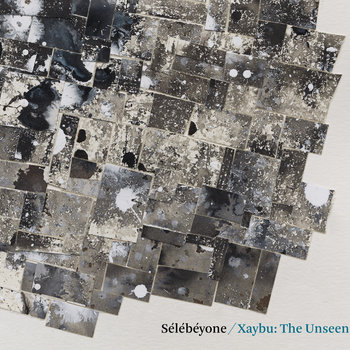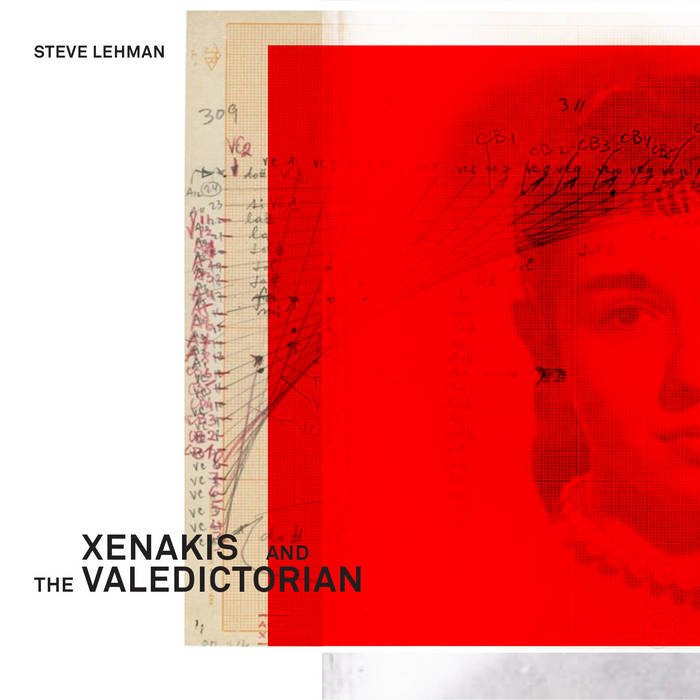Steve Lehman Ex Machina
Steve Lehman Ex Machina
Release Date: 15.09.2023
Steve Lehman – saxophone
Jonathan Finlayson – trumpet
Chris Dingman – vibraphone
Members of Orchestre National de Jazz:
Frédéric Maurin – direction, electronics; Fanny Ménégoz – flute, alto flute, piccolo
Catherine Delaunay – clarinet, basset horn; Julien Soro – tenor saxophone, clarinet
Fabien Debellefontaine – baritone saxophone, clarinet, flute; Fabien Norbert – trumpet, flugelhorn
Daniel Zimmermann – trombone; Christiane Bopp – trombone
Fanny Meteier – tuba; Bruno Ruder – piano, synthesizer
Stéphan Caracci – vibraphone, marimba, glockenspiel, percussion, synthesizer
Rafaël Koerner – drums; Sarah Murcia – double bass
Jérôme Nika – generative electronics creation & artistic collaboration
Dionysios Papanikolaou – IRCAM electronics
Ich muss nicht agieren ich interagiere
“Ex Machina ist eine neue Zusammenarbeit zwischen dem visionären Saxophonisten/Komponisten Steve Lehman und dem GRAMMY-nominierten Orchestre National de Jazz (ONJ). Es ist ein schillerndes neues Werk für Jazzorchester, das neue Maßstäbe für Innovationen im großen Ensembleformat setzt.
Mit Kompositionen sowohl von Lehman als auch von Frédéric Maurin, dem künstlerischen Leiter des ONJ, macht Ex Machina häufig Gebrauch von jenseitigen Spektralharmonien, die in Echtzeit durch die am IRCAM (Institut de Coordination Acoustique Musique) entwickelte interaktive Live-Elektronik verstärkt und transformiert werden. Die Solisten des Ensembles interagieren mit hochgradig nuancierten Harmonien, treibenden Polyrhythmen und computergesteuerten Klangumwandlungen und erzielen so einen mitreißenden Effekt. Es handelt sich zweifellos um eines der ehrgeizigsten Big-Band-Projekte der jüngeren Vergangenheit.”
Steve Lehmann Ex Machina
Die einen steigen aus, wenn ein Zuviel an Allgemeinplätzen strapaziert wird, andere steigen aus, wenn die Komplexität überhand nimmt – wieder andere stehen an der Seitenlinie und steigen nie ein – wie soll man da von gemeinsamem Nenner sprechen – steigen wir ein
Ja ein komplexes Album – für die, die Zuhören gelernt gaben, hat es einen intravenösen Zugang – das geht über zurückhaltende und zurückgenommene Bläsersätze, die pianissimo aufbereiten, was jederzeit implodieren oder überdrehen könnte – Musiker haben das Repertoire, sich komplett aus der Bahn zu werfen – indem sie überkompensieren oder überinterpretieren oder alles derart überhöhen, dass das Hören quasi willenlos und ohnmächtig erfolgt
Die ersten acht Minuten geben in 39 die Richtung vor: es wird gleich klar, dass es sich um ein Vielstimmenprojekt handelt mit Dissonanztonlagen.
In Los Angeles Imaganery haben wir eine überfüllte Kulisse, in die kräftig hineingeblasen wird – Großstadt-Leben bildet sich ab wie ein multiples Lexiversum, Verkehrslärm übertönt die einzelnen Aussagen – der Istzustand ist ein wilder Aussageraum ohne Halt und Kontrast – mehr und mehr ein sich erschöpfender Umkehrraum aller im Tumult mit allen
Aus der Architektur kennen wir die Lehre, dem organischen Chaos eine Form zu geben, kennen aber auch die Spielart des Genius Loci – der Anpassung an seine Umgebung, um ihr zu entsprechen –
Chimera eröffnet eine Tiefenraumspannung – um ebenfalls in ein Multiplexmuseum oder Kino zu wechseln, als Film oder cineastisch Bilder entwerfender Streifen läuft die Aufnahme wieder intravenös – keine einfachen Bilder, eher vielschichtig – wir kennen die Lehre der Architektur: wird ein Objekt konkret, indem es die Natur nachbildet oder ihr zu entsprechen versucht oder wird es sichtbar erst, wenn es zur eigenen Form findet – zur Abstraktion?
Alchimie – wie der Titel vermuten lässt – es wird noch biomorpher, noch organischer, noch strudelnder und wie in Schleifen seiner selbst um sich kreisend, die Alchemie: das lässt sich deuten als mittelalterliche Sicht auf die Dinge, da man die Reaktionen der Stoffe zu- und aufeinander noch nicht kalkulieren und einschätzen konnte, sie vielmehr in ihrer Wirkung bestaunte.
Ode to aklaff: eine Klangkollage – Universität trifft auf Versuch und Irrtum – das ganze Experiment der aufeinander wirkenden Teilchen – halte einen tönenden Stab an einen Stein und versuche zu hören, wie der Stein klingt – Lehmann geht gleich weiter und lässt den Stein sich selbst erodieren.
Bis hier sind wir im Konzept der Entdeckungsreisen – wir durchschreiten die historischen Möglichkeitsformen und spielen und tarieren sie aus – haben offenbar eine Vielstimmenautorenrunde vor uns – was wir hören ist: Umgangsformen wie die im Film auf der Bühne oder auch im eigenen bekannten Umfeld, wenn alle gleichzeitig sprechen.
Jeux d’ Anchez – wir kreisen – Rhythmussektion zitiert im Beat – die Trompete spielt im Rahmen ihrer Quinten – Formwechsel über das Vibraphone – der atonale Nachhall erhöht die Schwierigkeitskala – wenn du hörst, wie jeder Ton hinter dir her ist – vertrackt intelligent verfangend – wie Big als Band an sich selbt nagt,
Les Treize Soleils – die gestörte Flöte – unterwandert von Schrummelgeräuschen – aus der Rhythmussektion – vereinzelt wagt die Flöte einen Höhenflug – wird eingefangen vom Beat – streng: Trompete hebt ab – frage steht; zwei drei oder vier Welten und wer jagt oder treibt wen? Alles im traditionellen Sinn: es ist nicht multikomplex, es ist multiphon plus Saxophon – Struktur ums Individuum, oder Individuum in der Struktur?
Speed-Freeze, Pt. 1, wer eingefrorene Geschwindigkeit erwartet, wird der Klangkollage ausgesetzt – Saxophon spielt gegen Spielautomat? Nein, es spielt nicht gegen an, es wird niedergerungen, um über die Piano-Kaskade wiederbelebt zu werden – hier aber alle Viere streckt – dramaturgischer Tief- oder Hochpunkt – bis dahin, dass du mehr das Klappern der Tastaturhälse vernimmst als den eigenen saxophonen Aufschrei. Den übernimmt das Orchester im Bassbereich mit Posaune und Rasseln der Utensilien
Erinnere dich daran – die Aufnahme heißt Ex Machina – aus der Maschine (heraus?) oder (in sie zurück?) Wehren sie sich oder arrangieren sie sich?
Speed-Freeze, Pt. 2 dreht das Spiel – jetzt dürfen zwei Saxophone über einem Grundton an Beat sich Vorwürfe machen und extrapolieren – sie positionieren sich trotzdem nicht – sie passen sich den unterschiedlichen auf- wie absteigenden Stufen der Rhythmusmaschine an – du kannst reden und sagen was du willst, die Machina wälzt sich selbstzufrieden in eigenen Tonstärken und Crescendi durch den Raum und färbt ihn ein – wer führt Regie?
Le seiul, Pt. 1 und Le seiul, Pt. 2 haben sich ans Regelwerk zu halten – sie machen, was erwartbar war: einen dramatischen Akt um sich selbst – wenn das Konzept durchschaut ist, dürfen sich die Eigenständigkeiten zeigen? Nun, du wartest in Pt. 1 lange auf die befreiende Solostimme – die bezeichnend dann: aus den Tiefen kommt – von der Posaune – dem lieblichsten Gruß unter den Backgroundinstrumenten – der Film hat alles in Raumbilder verfrachtet und eingefangen – hält sich selbst für abgesichert und kann Klangschalen verabreichen – eine Machina verabreicht sich übrig gebliebene Klangtonspuren auf Stein, Metall, gegen Stangen und Gitter – selbst die Freitonassoziationen sind inzwischen eingezäunt.
Ganz so dunkel soll der Film nicht enden – in Le seuil, Pt. 2 erhebt die Posaune etwas deutlicher ihre Stimme – zeigt noch einmal ein Hier-ich, kann den eigenen Interventionen kaum ausweichen, ihnen kaum entkommen: die Machina ist wie die Matrix nicht willens, den Solisten die Entscheidung abzunehmen – sie genügt sich inzwischen selbst.
Für Jazztrail ist das Werk schlicht ein Muss – bei Karl Ackermann von Allaboutjazz erfahren wir noch einiges zum Thema Ki-Anwendungen in der Musik. Steve Lehmanns Gesamtwerk ist repräsentiert auf Bandcamp, seinen Lebenslauf findest du auf Wiki deutsch und Wiki English
Steve Lehman Ex Machina
– english version
Ex Machina is a new collaboration between visionary saxophonist/composer Steve Lehman and the GRAMMY-nominated Orchestre National de Jazz (ONJ). It is a dazzling new work for jazz orchestra that sets a new standard for innovation in the large ensemble format. With compositions by both Lehman and ONJ’s artistic director, Frédéric Maurin, Ex Machina makes frequent use of otherworldly spectral harmonies that are reinforced and transformed, in real-time by live, interactive electronics developed at IRCAM (Institut de Coordination Acoustique Musique). Soloists in the ensemble interact with highly-nuanced harmonies, propulsive polyrhythms, and computer-driven sound transformations to thrilling effect. It’s indisputably one of the most ambitious projects for jazz big band in recent memory.
Some get off when too much generalities are strained, others get off when the complexity gets out of hand – still others stand on the sidelines and never get on – how can one speak of a common denominator – let’s get on board.
Yes, a complex album – for those who have learned to listen, it has an intravenous approach – this goes via restrained and withdrawn brass sections, which prepare pianissimo what could implode or go over the top at any time – musicians have the repertoire to throw themselves completely off track – by overcompensating or overinterpreting or exaggerating everything in such a way that listening takes place almost willy-nilly and powerlessly.
The first eight minutes set the tone in 39: it is immediately clear that this is a multi-voice project with dissonant pitches.
In Los Angeles Imaganery we have a crowded backdrop that is blown into vigorously – big city life is depicted like a multiple lexiverse, traffic noise drowns out the individual statements – the actual state is a wild exterior space without support or contrast – more and more an exhausting inversion space of everyone in turmoil with everyone else.
From architecture we know the lesson of giving organic chaos a formal form, but we also know the play of genius loci – of adapting to one’s surroundings in order to conform to them –
Chimera opens up a depth-space tension – to likewise switch to a multiplex museum or cinema, as a film or cinematic image-designing strip, the shot runs intravenously again – no simple images, rather multi-layered – we know the lesson of architecture: does an object become concrete by imitating nature or trying to correspond to it, or does it only become visible when it finds its own form – abstraction?
Alchimie – as the title suggests – it becomes even more biomorphic, even more organic, even more swirling and circling around itself as if in loops, alchemy: this can be interpreted as a medieval view of things, since one could not yet calculate and assess the reactions of substances to and on each other, but rather marvelled at their effects.
Ode to aklaff: a sound collage – university meets trial and error – the whole experiment of particles acting on each other – hold a sounding stick to a stone and try to hear how the stone sounds – Lehmann goes straight on and lets the stone erode itself.
Up to here we are in the concept of voyages of discovery – we walk through the historical forms of possibility and play and balance them out – obviously we have a multi-voice author round in front of us – what we hear is: manners like those in the film on stage or even in our own familiar surroundings when everyone speaks at the same time.
Jeux d’ Anches – we circle – rhythm section quoted in the beat – the trumpet plays within its fifths – change of form over the vibraphone – the atonal reverberation increases the scale of difficulty – when you hear how every note is after you – intricately intelligent entangling – how Big as a band gnaws at itself,
Les Treize Soleils – the disturbed flute – infiltrated by buzzing noises – from the rhythm section – occasionally the flute dares to soar – is caught by the beat – strict: trumpet takes off – ask stands; two three or four worlds and who chases or drives whom? All in the traditional sense: it’s not multicomplex, it’s multiphon plus saxophone – structure around the individual, or individuum in the structure?
Speed-Freeze, Pt. 1, those who expect frozen speed are exposed to sound collage – saxophone plays against slot machine? No, it doesn’t play against it, it is beaten down to be revived by the piano cascade – but here it stretches all fours – dramaturgical low or high point – to the point that you hear more the clatter of the keyboard necks than your own saxophone cry. The orchestra takes over in the bass range with trombone and rattling of the utensils.
Remember – the recording is called Ex Machina – out of the machine (out?) or (back into it?) Are they resisting or arranging?
Speed-Freeze, Pt. 2 turns the game – now two saxophones are allowed to reproach and extrapolate over a basic tone on beat – they still don’t position themselves – they adapt to the different ascending and descending stages of the rhythm machine – you can talk and say what you want, the machina rolls through the space self-satisfied in its own tonal strengths and crescendos and colours it – who directs?
Le seiul, Pt. 1 and Le seiul, Pt. 2 have to stick to the rulebook – they do what was expected: a dramatic act around themselves – when the concept is seen through, are the autonomies allowed to show themselves? Well, you wait a long time in Pt. 1 for the liberating solo voice – which characteristically then: comes from the depths – from the trombone – the sweetest greeting among the background instruments – the film has shipped and captured everything in spatial images – considers itself secured and can administer sound bowls – a machina administers itself leftover sound traces on stone, metal, against bars and grids – even the free sound associations are fenced in by now.
The film is not meant to end quite so darkly – in Le seuil, Pt. 2, the trombone raises its voice a little more clearly – once again shows a here-me, can hardly avoid its own interventions, hardly escape them: the machina, like the matrix, is not willing to take the decision from the soloists – in the meantime, it is sufficient for itself.
For Jazztrail, the work is simply a must – Karl Ackermann from Allaboutjazz tells us a lot more about Ki applications in music. Steve Lehmann’s complete works are represented on Bandcamp, you can find his curriculum vitae on Wiki German and Wiki English.
>>> Jazz Albums July >>> * Jazz Albums USA 2021 * Jazz News 2023



